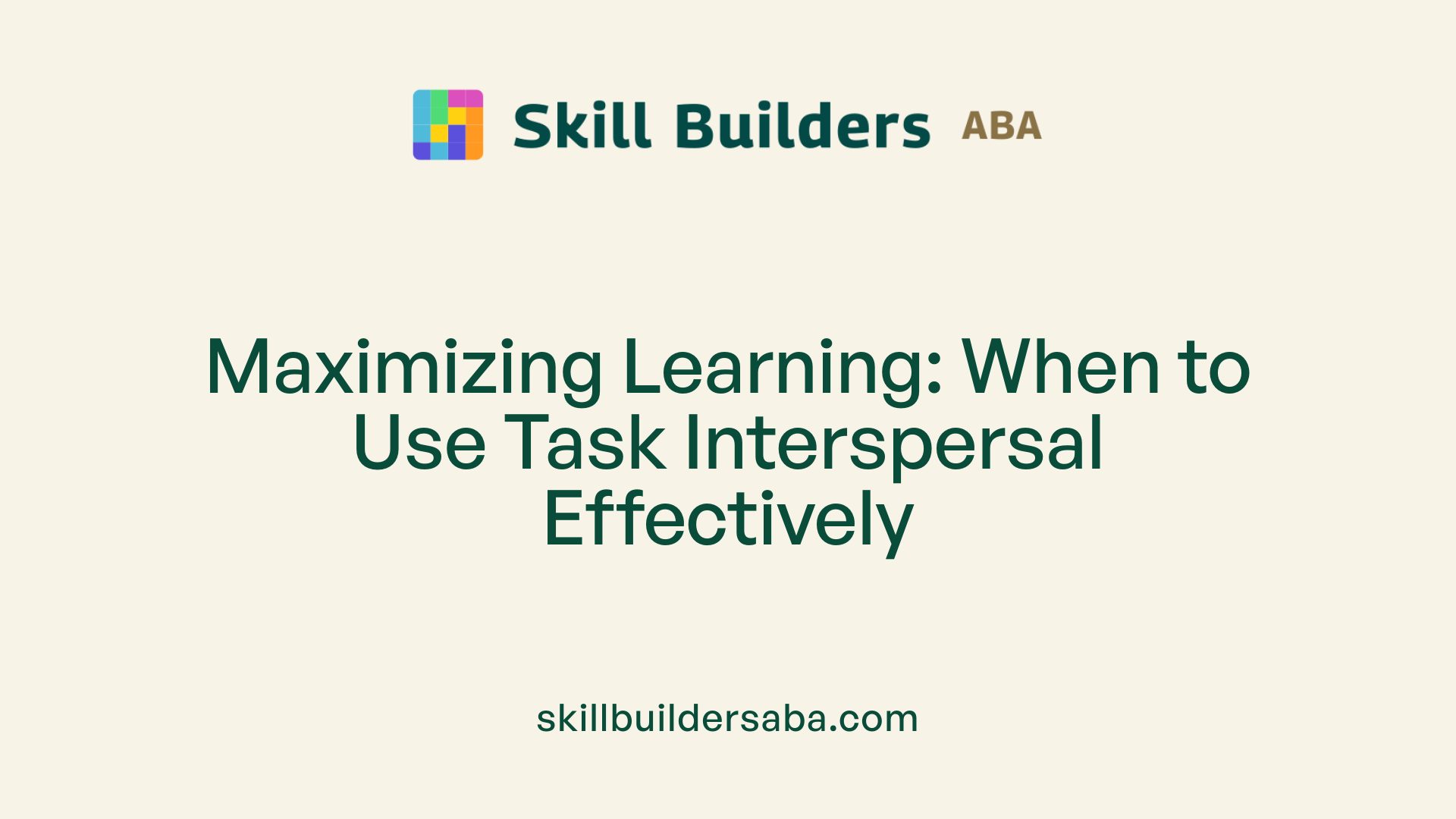What is task interspersal and when is it useful
Harnessing the Power of Task Interspersal in Education and Behavioral Interventions

Understanding Task Interspersal: A Key Strategy for Effective Learning
Task interspersal is an instructional technique that strategically mixes tasks of varying difficulty levels within a learning session. Rooted in reinforcement principles, this method involves inserting mastered or preferred tasks among less familiar or challenging ones to improve engagement, motivation, and learning outcomes. Its flexible nature allows practitioners to tailor interventions to individual needs, making it a popular approach especially for children with autism and other neurodevelopmental disorders.
Defining Task Interspersal and Its Core Principles

What is the meaning of task interspersal?
Task interspersal is a teaching and organizational strategy that involves inserting or mixing different tasks at intervals within a sequence of activities. Instead of working on one task continuously until completion, this method places mastered or preferred tasks intermittently among unlearned or challenging tasks.
In educational settings, particularly with children with autism spectrum disorder, task interspersal is used to enhance motivation, increase correct responses, and maintain engagement. It relies on the principle that successfully completed easier or known tasks serve as reinforcers, thereby creating positive momentum.
This process involves deliberate spacing of tasks, often combining easy or well-mastered tasks with harder, less familiar ones. Various procedural variations of task interspersal exist, but all aim to facilitate learning, reduce frustration, and improve behavioral and academic outcomes.
Interspersion and its application in workflow
Applying interspersion in a workflow setting means strategically alternating between different types of tasks or stimuli. This is not merely about random switching but involves thoughtful placement of tasks—such as mixing new or difficult tasks with familiar or easier ones—to optimize performance and motivation.
For example, in a classroom, a teacher might schedule a series of math problems where easier problems are interleaved with more difficult ones. This approach encourages perseverance, boosts confidence, and helps prevent boredom or burnout.
In a broader sense, interspersal helps manage workload, improve compliance, and sustain attention. Its effectiveness has been supported by research showing increases in correct responses and task completion rates.
Strategies for spacing out tasks effectively
Implementing task interspersal successfully involves several strategies:
- Ratio Planning: Commonly using a ratio such as 1:3 (one new or difficult task for every three mastered or preferred tasks).
- Task Selection: Including only tasks that are truly mastered or highly preferred to serve as effective reinforcers.
- Sequence Design: Mixing tasks of similar or dissimilar difficulty levels, based on individual needs.
- Reinforcement Application: Providing praise, tangible rewards, or edibles for successful completion, especially on unlearned or harder tasks.
- Adjustments Based on Feedback: Monitoring performance and behavioral responses to modify ratios and task types.
Overall, these strategies aim to create a balanced, motivating environment that supports learning and minimizes frustration or problematic behaviors.
The Role of Task Analysis in Developing Interspersal Strategies

Why is task analysis useful in designing effective interventions?
Task analysis is an essential tool in creating successful instructional strategies, especially when implementing methods like task interspersal for children with autism. It involves systematically breaking down complex skills into smaller, manageable steps. This detailed approach allows educators and clinicians to understand exactly how a learner accomplishes a specific task.
By analyzing these steps, intervention designers can identify potential difficulties and tailor teaching procedures to suit individual needs. Precise task analysis ensures that interventions are not only effective but also efficient, targeting the right skills at the right time.
Moreover, this process promotes clear communication among educators, therapists, and caregivers. It helps in training staff and tracking progress over time. Since task analysis is evidence-informed and adaptable, it provides a solid foundation for developing interventions that are both realistic and responsive to each learner's unique profile.
Overall, the significance of task analysis in behavioral interventions lies in its ability to guide the systematic, personalized, and effective teaching of new skills, maximizing learning outcomes and supporting positive behavior development.
When and Why Is Task Interspersal Particularly Useful?

When is task interspersal useful?
Task interspersal proves especially beneficial in settings where boosting motivation and engagement are priorities. It helps learners, particularly those with autism or other developmental disabilities, stay attentive and respond accurately during learning activities.
This technique involves mixing difficult or new tasks with mastered or easier ones. By doing so, it creates opportunities for success and reduces feelings of frustration. Learners experience more frequent reinforcement, which keeps their interest high and encourages continued participation.
Moreover, task interspersal can be effective even when the reinforcement quality is lower because the repeated success on easier tasks provides motivation. Including praise, tangible rewards, or preferred activities for both mastered and new tasks reinforces ongoing learning and response persistence.
However, it’s important to recognize that the success of task interspersal depends on various factors like how difficult the tasks are, the type of reinforcement used, and individual learner needs. For instance, some learners may respond better to more frequent reinforcement or different ratios of mastered to unmastered tasks.
In educational and behavioral contexts, this strategy supports skill development, helps prevent boredom, and reduces problem behaviors such as noncompliance, aggression, or self-injury. Overall, it is a flexible and effective way to facilitate learning while maintaining student motivation and reducing frustration.
Practical application in classroom and therapy
Teachers and clinicians utilize task interspersal as a part of instructional planning, adapting procedures based on individual characteristics and session goals. Whether used across entire classrooms or tailored for individual learners, task interspersal remains an accessible tool for fostering continuous engagement and promoting positive learning experiences.
Benefits, Outcomes, and Scientific Support for Task Interspersal

What are the benefits and purposes of task interspersal, especially for children with autism or developmental disabilities?
Task interspersal involves mixing easier, mastered tasks with new or more difficult ones during instruction. This approach aims to boost motivation, engagement, and learning in children with autism or developmental challenges. Research shows that by alternating familiar activities with new ones, children tend to respond more positively, stay focused longer, and learn new skills more efficiently.
This method also helps maintain children's interest and fosters skill generalization by encouraging sustained attention. It can reduce frustration and problematic behaviors like noncompliance or aggression by providing successful experiences through easier tasks. Moreover, tailoring the ratio of mastered to new tasks and incorporating reinforcement—like praise or preferred items—further enhances effectiveness.
Practitioners can adapt task interspersal to fit each child's needs and preferences, making it a flexible strategy. When correctly implemented, it promotes faster learning, higher motivation, and better task compliance, ultimately encouraging more active participation in instructional sessions.
How does research support the effectiveness of task interspersal?
Numerous studies validate the benefits of task interspersal for individuals with autism and related disorders. Research employing rigorous designs, such as multiple-baseline procedures, consistently demonstrates increased correct responses and skill acquisition when using interspersal techniques.
A common finding is that higher ratios of known or mastered tasks to new tasks—such as a 3:1 ratio—are associated with positive learning outcomes. This method has been shown to preserve or enhance performance even when reinforcement levels are reduced, indicating that interspersal supports durable learning.
Additionally, research highlights that interspersal can improve motivation by making tasks more manageable and rewarding. It can also decrease behaviors like self-injury or aggression, particularly when reinforcement strategies are aligned with individual preferences.
Overall, empirical evidence strongly indicates that task interspersal is an effective educational strategy, supported by various scientific investigations and practitioner reports, for fostering more efficient, generalized, and motivated learning in children with autism.
| Aspect | Findings | Additional Details |
|---|---|---|
| Learning Improvement | Increases correct responses and skill mastery | Supported by multiple baseline research studies |
| Reinforcement Effectiveness | Sustains performance with reduced reinforcement | Response to reinforcement density variations |
| Motivation | Enhances engagement and positive affect | Students prefer interspersed learning sessions |
| Behavioral Benefits | Reduces problematic behaviors | Decreases noncompliance and aggression |
| Adaptability | Tailorable to individual needs | Ratios and procedural variations can be customized |
These findings demonstrate that task interspersal, when applied thoughtfully, can significantly benefit instructional outcomes for children with autism, making learning more engaging, efficient, and sustainable.
Practical Applications and Scenarios for Task Interspersal Use

In what scenarios can task interspersal be effectively applied?
Task interspersal is a versatile teaching method particularly suited for use in classroom and clinical settings where the goal is to boost task completion, student engagement, and compliance. It is especially effective with learners who benefit from increased motivation and confidence, such as children with autism spectrum disorder.
Research indicates that inserting brief, mastered, or preferred tasks within academic activities enhances the likelihood of continued student participation. These tasks act as conditioned reinforcers, meaning that their completion becomes rewarding in itself—motivating students to take on more unlearned or challenging tasks.
The underlying principle, known as the discrete task completion hypothesis, shows a strong linear relationship between the rate at which students complete problems and their preference for assignments that include interspersed tasks. This means that when students experience frequent success on easier or known tasks, they are more likely to choose and persist with interspersed assignments over time.
This approach is particularly beneficial during instruction in academic skills such as math, spelling, sequencing, and labeling. By alternating easier or previously mastered tasks with more difficult new tasks, educators can create a motivating learning environment that reinforces persistence and minimizes frustration.
In summary, task interspersal is most effective when the interleaved tasks serve as reinforcing agents—thus promoting active participation, improving learning outcomes, and fostering a positive attitude towards learning. Its adaptability makes it suitable for individual therapy sessions and classroom-based instruction aimed at maintaining motivation and encouraging skill acquisition.
Summing Up the Power of Task Interspersal
Incorporating task interspersal into educational and behavioral interventions offers a strategic way to boost motivation, increase engagement, and improve learning outcomes, particularly for children with autism and developmental disabilities. Supported by extensive research, this flexible technique allows for individual customization and can be integrated into various settings to foster skill acquisition and reduce problematic behaviors. As practitioners continue to explore the optimal use of interspersal, it remains a vital component of evidence-based strategies to optimize learning and behavior change.
References
- Task interspersal and performance of matching ... - ScienceDirect.com
- Task Interspersal: a Meta-Analytic Review of Effective Programming
- Sage Reference - Task Interspersal
- EJ1421632 - Task Interspersal: A Meta-Analytic Review of ... - ERIC
- "Too Much Reinforcement, Too Little Behavior: Assessing Task ...
- [PDF] WHY IS IT INTERSPERSING TASKS - AWS
- Task Interspersal Implementation Practices with Individuals with ...
- Task interspersal for individuals with autism and other ...
- Activity Sequencing - MoEdu-SAIL
.svg)














